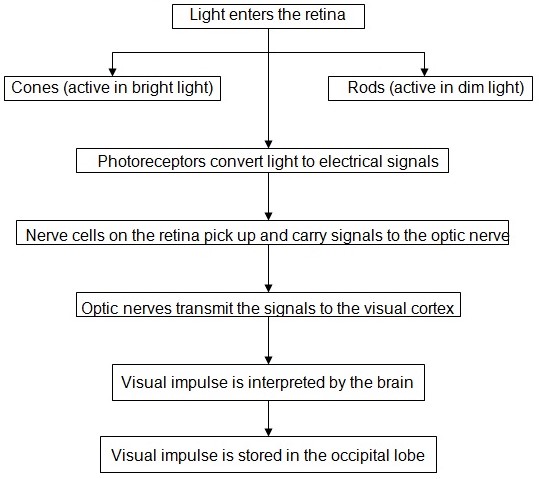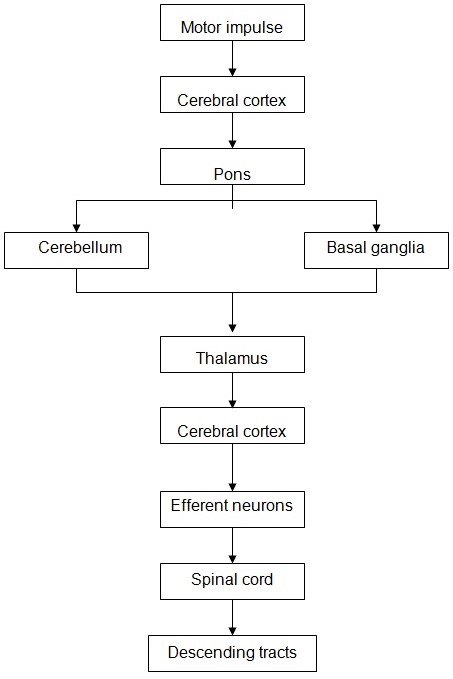The Sequential Flow of Visual Information


There are three processes involved in the sensory function of the eyes: the mechanical process, the chemical process, and the electrical process. The mechanical process starts as the stimuli (light) passes through the cornea and the pupil than to the lens. Then the cornea’s shape focuses the incoming stimuli slightly before it enters the lens, or it is refracted. After which, the iris now can shrink the pupil (when the stimuli are the bright light, it lets in less light), or expand the pupil (when stimuli are dim light, it lets in more light). When the light passes through the lens, it is bent and focuses on the photoreceptors. Then the ciliary muscles and ligaments cause the lens to change in shape, letting the lens focus light from both distant and nearby objects onto the retina (accommodation).
The chemical process starts as the photoreceptors receive the light and convert it to electrical signals. The cones, which are active in bright light conditions, detect and interpret colors, pick up small changes (also known as visual acuity) such as threading a needle, and then the photoreceptors pick up these signals coming from the center of the visual field. The rods, which are active in dim conditions, pick up small bits of light from here and there and are also used for peripheral vision (Protect-your-eyesight).
The electrical process starts as photoreceptors convert the light into electrical signals. The nerve cells, which sit on top of the rods and cones, pick up the signals and carry them to the optic nerve. The optic nerve now takes the signals to the visual cortex where the brain reinterprets the signals as what you are seeing (Protect-your-eyesight). The brain acts further as the visual impulse is converted to memory that specifically happens in the occipital lobe of the brain, where visual information is processed (Cohen and Taylor, 2005).
The Sequential Flow of Motor Information

The cerebral cortex is the structure in the brain that has 4 lobes, the frontal, parietal, temporal, and occipital. Its main function is associated with the actual information processing in the brain. It sends impulses to the cerebellum and basal ganglia via pons, and then these structures also send back the information to the cerebral cortex via the thalamus. The cerebellum sends out positive feedback, while basal ganglia send out negative feedback.
The basal ganglia are a collection of nuclei found deep in the fissures of the cerebral cortex. The caudate and putamen (nuclei found at the very deep part of the cerebral cortex’s white matter) receive input from the cerebral cortex. These structures are connected to the substantia nigra, but the output is sent to the globus pallidus. The impulse is then transmitted to the thalamus, then back to the cerebral cortex.
Cerebellum, a structure involved in movement coordination, receives impulses from the cerebral cortex through 3 inputs, which are the spinocerebellar pathway, inferior olive, and pons. The result is transmitted through the 3 outputs, which are fastigial, interposed, and dentate nuclei.
The spinal cord, through the efferent neurons, transmits the motor impulses to the descending tracts in the spinal cord which carry information from the brain the different parts associated with the motor impulse (Molavi, 1997).
Learning and Memory
Learning and memory are differentiated by the way people act upon them. Learning is defined as the process which may affect how humans will change subsequent behaviors. Memory is the term associated with remembering and storing information in specific parts of the brain (Dubuc, 2002).
There are two types of long-term memory. Declarative memories (explicit memories) are the memories associated with what people store in their minds which they can describe, for example, the details of a movie review, the appearance of a favorite actor, or the lyrics of the songs. The other one is Non-declarative memories (implicit memories), which are the memories that people keep in their minds which they can’t express, for example, dancing gracefully, wrapping a gift, or basically, the things that we need to demonstrate to be able for us to explain better what we want people to perceive (Dubuc, 2002).
The forms of learning associated with declarative memories include the actual perception of the learning material/task, wherein the person uses few sensory organs in obtaining information from other people, media, etc.
The forms of learning associated with non-declarative memories include an actual demonstration by people or through media and the use of more sensory organs since this form of memory requires us to obtain long-term memory from our brain by putting into action the stored information.
The relationship between knowledge, creativity, and action is best observed in the difference between algorithms and insight.
There are a lot of differences and relationships that we’ll go through when we talk of knowledge, creativity, and action.
Knowledge is defined as the general awareness or possession of information, facts, ideas, truths, or principles. Creativity is the ability to use the imagination to develop new and original ideas or things, especially in an artistic context. Action is defined as the process of doing something to achieve a purpose (Encarta, 2007).
In understanding the sentence “The relationship between knowledge, creativity and action is best observed in the difference between algorithms and insight”, we have to think of an actual situation when knowledge, creativity, and action will manifest a close relationship. Imagine that two people are applying for an artist job, one who graduated as AB Fine Arts (with basic computer knowledge) and the other as BS Computer Science (knowledge). The recruitment representative asks the two to create an advertisement using the computer. The tendency for the AB Fine Arts graduate is to use his basic computer knowledge in making the advertisement, while the BS Computer Science graduate will use his complex computer-related knowledge in making his advertisement, making arts just secondary to his various computer-generated craft (creativity and action). Who do you think will get the job?
The point is, these three things are related to each other because when one uses his knowledge, he can derive creativity from it, and through it, and his action is affected. The lesser knowledge we have the small possibility for creativity to occur. The more knowledge we possess, the more creative thoughts will preoccupy us and subsequent actions based on that will occur.
References
Cohen, Barbara, and Taylor, Jayson. Memmler’s The Human Body in Health and Disease: Human Body In Health And Disease. Lippincott Williams & Wilkins, 2005.
Protect-your-eyesight.com. The Visual Process: How The Eyes Work. 2008. Web.
Molavi, Diana. Neuroscience Tutorial: An illustrated guide to the essential basics of clinical neuroscience Washington University Program in Neuroscience. 2008. Web.
Encarta: World English Dictionary [North American Edition. 2007. Bloomsbury Publishing Plc. 2008. Web.
Dubuc, Bruno. “Memory and Learning and different Types of Long-term memory”. 2002. The brain from top to bottom. 2008. Web.